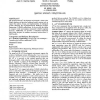4311 search results - page 29 / 863 » Code Generation for Distributed Systems |
OSDI
1994
ACM
13 years 9 months ago
1994
ACM
A fine-grain parallel program is one in which processes are typically small, ranging from a few to a few hundred instructions. Fine-grain parallelism arises naturally in many situ...
NIPS
1996
13 years 9 months ago
1996
We present a general encoding-decoding framework for interpreting the activity of a population of units. A standard population code interpretation method, the Poisson model, start...
ATAL
2009
Springer
14 years 2 months ago
2009
Springer
The agentTool III (aT3 ) development environment is built on the Eclipse platform and provides traditional model creation tools to support the analysis, design, and implementation...
PC
2006
13 years 7 months ago
2006
Tiling is a well known loop transformation used to reduce communication overhead in distributed memory machines. Although a lot of theoretical research has been done concerning th...
SRDS
2007
IEEE
14 years 1 months ago
2007
IEEE
Sensors that operate in an unattended, harsh or hostile environment are vulnerable to compromises because their low costs preclude the use of expensive tamper-resistant hardware. ...


